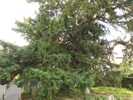Screveton St WilfridChurchyard
 The east side of The east side of
the churchyard |
The road does not lead directly up to the church – there is a stone path leading to the entrance to the churchyard, which is to the north-east of the church. The road continues to the west and there are private dwellings to the west and south of the church.
The churchyard is approximately square in shape, with the church offset into the south-west corner. There is a private dwelling at the east end of the churchyard, dated to the early 17th century, said to possibly occupy the site of a former priest’s house, and is named as such ‘The Old Priest’s House’.
The path of short-cut grass runs from the north-east corner, in front of the church to the east, and around the south aisle to the porch in the south-west corner.
 Yew tree Yew tree |
The oldest burials are those to the north and east of the church. Those to the east are obscured by long grass. The burials on the south side are mostly from the 19th century. The area currently in use is a new corner to the north-east, directly to the east of the entrance to the churchyard, with a bench and a yew tree.
Close to the porch at the south west corner are two 19th-century tombs with memorial stones to members of the Marsh family.
Just south-west of the porch is a stone sundial, listed Grade II, dated to 1732 and inscribed:

| Tho. Hall Screveton/Jacob Marshall Ch.Wr. 1732 |
 The churchyard contains an unusual grave marker to a Freemason who died in 1820. According to the Stamford Mercury, William Gibson, a farmer, was 'distinguished in the prime of life as a zealous freemason, having by acquirements in the science and art made himself perfect in the different degrees next to the Provincial Grand Master for the county of Nottingham. He belonged to the respective lodges in Nottingham and Newark.' Part of the inscription reads: The churchyard contains an unusual grave marker to a Freemason who died in 1820. According to the Stamford Mercury, William Gibson, a farmer, was 'distinguished in the prime of life as a zealous freemason, having by acquirements in the science and art made himself perfect in the different degrees next to the Provincial Grand Master for the county of Nottingham. He belonged to the respective lodges in Nottingham and Newark.' Part of the inscription reads:
William Gibson, A.P.G.M. for the County
of Nottingham, R.A. and K.T.St.J.
of J.K.D.O.S.H. |
|